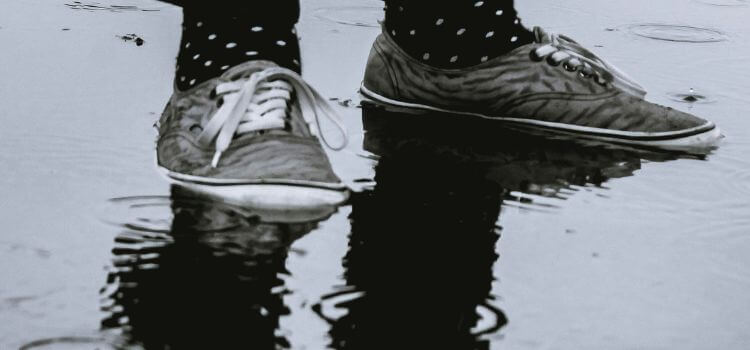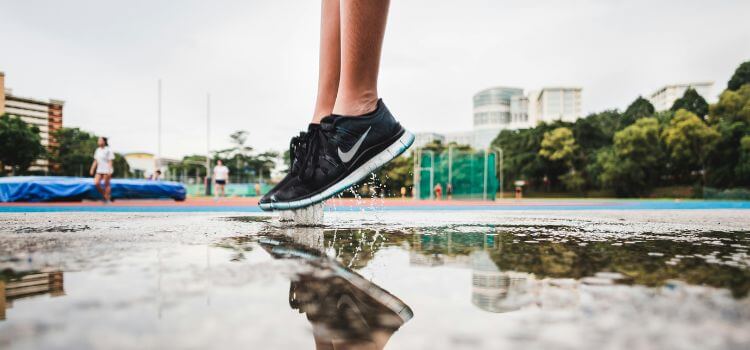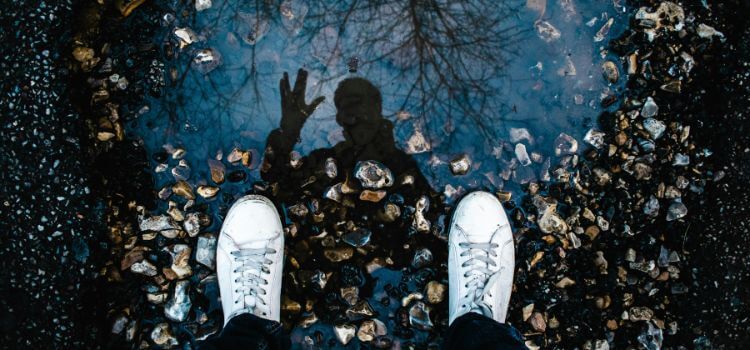Yes, you can wear socks with water shoes for added comfort. However, to maintain dryness and warmth, it is advisable to opt for water-resistant socks.
Water shoes, designed to protect your feet while engaging in aquatic activities, can be enhanced with the right pair of socks. Wearing socks with water shoes can prevent blisters, provide extra cushioning, and offer warmth in colder waters. This is especially useful for those involved in extended water-based activities or sensitive to rough materials often found in water shoes.

Ensuring a proper fit is crucial as socks can alter the shoe’s interior space; therefore, a trial before your adventure is recommended to avoid any discomfort or slipping issues. Selecting specialized aqua socks or thin, quick-drying fabrics will maximize the benefits while maintaining the functionality of your water shoes.
Socked And Shoed: A Water-ready Combo?
Think about walking along a riverbank or standing on a slick boat deck. Now, imagine keeping your feet both protected and comfortable. That’s the magic of pairing socks with water shoes. Let’s explore why this duo is making waves in aquatic adventures!
Comfort Meets Purpose: Socks In Water Shoes
Water shoes alone do wonders for foot safety. Add socks? You get a game-changer for comfort. Here’s how socks amp up your water shoe experience:
- Enhanced Comfort: Socks cushion your feet inside water shoes. Less rubbing, more fun!
- Better Fit: A pair of socks can make loose water shoes feel snug. No more slips!
- Temperature Control: In cold water, insulated socks keep toes toasty. In hot weather, moisture-wicking socks help cool them down.
Hygiene Factors: Keeping Feet Healthy
Healthy feet are happy feet, especially in damp environments. Here’s how socks help:
| Benefit | Description |
| Moisture Management | Socks wick away sweat and water. This keeps your feet dry and reduces odour. |
| Barrier Protection | A sock acts as a barrier. It prevents dirt and sand from irritating. |
| Reduced Friction | Fewer blisters form when socks minimize rubbing inside water shoes. |
Maintaining foot hygiene becomes straightforward with socks. Make sure you choose the right type of socks for the best results.
The Great Debate: Socks Versus Bare Feet In Water Shoes
Picture this: You’re ready for a day at the beach or a walk by the river. Your water shoes are a must, but should you grab your socks, too? This is a hot topic for outdoor enthusiasts and casual water-goers. Some swear by socks for extra comfort, while others tout the pure feel of bare feet encased in water shoes.
Pros Of Pairing Socks With Water Shoes
Let’s explore why some adventurers choose socks with their water shoes.
- Added Comfort: Socks can prevent blisters and chafing and are indispensable for long activities.
- Warmth: They keep toes cozy in colder waters, a must for chilly adventures.
- Protection: Extra layer guards against pebbles and sharp objects.
- Hygiene: Socks help combat odours and can be changed easily.
Cons: When Socks And Water Shoes Don’t Mix
However, socks are only sometimes the perfect partners for water shoes.
- Water Retention: Some socks absorb water, becoming heavy and uncomfortable.
- Drying Time: Wet socks take longer to dry and are not ideal for frequent water entry and exit.
- Fit Issues: Socks may alter the fit of water shoes, compromising performance.
- Sand Intrusion: Sand can get trapped between socks and shoes, which is irritating.
Types Of Water Shoes: Compatibility With Socks
Exploring water environments calls for the right gear. Owners of water shoes often wonder about wearing socks. Let’s dive into the types of water shoes and their compatibility with socks.

Closed-toe Adventures: Ideal Sock Situations
Closed-toe water shoes offer great protection. They pair well with socks. Here’s why:
- Extra Cushioning: Socks provide comfort during long treks.
- Warmth: They keep their feet warm in cold water.
- Blister Prevention: Socks reduce friction, preventing blisters.
Best socks for these shoes:
- Quick-dry materials, like synthetic or merino wool
- Snug fit to avoid bunching
- Minimal seams for comfort
Open-toe Designs: Sock Considerations
Open-toe water shoes are airy and quick-drying. They have unique sock needs:
- Snag Risks: Socks can get caught on open sections.
- Sand Entry: Open designs may let sand in, causing discomfort with socks.
- Style: Visible socks might only be one of some people’s choices.
Choose wisely:
| Activity | Sock Choice |
| Beach walking | No socks or toe socks |
| Water sports | Thin, fitted water socks |
| Relaxed swimming | Optional based on comfort |
Material Matters: Best Socks For Water Shoes
Choosing the right socks for water shoes is crucial. They keep feet comfortable and dry. From strolling on the beach to hiking near rivers, the correct material can enhance your experience. Today, let’s explore the fabrics and sock types best suited for water shoes.

Water-resistant Fabrics: What Works Best
Not all fabrics are equal when it comes to water activities. The ideal material should repel water yet allow your feet to breathe. Here are the top materials:
- Neoprene: It acts like a wet suit for your feet.
- Lycra: Stretchy and dries fast.
- Nylon: Tough against abrasion and quick drying.
- CoolMax: Wicks moisture away efficiently.
Avoiding Blisters: Selecting The Right Sock Type
Blisters can ruin water adventures. The right sock type prevents them. Consider these features:
| Feature | Benefit |
| Seamless | Reduces friction |
| Padded Heels | Offers extra cushioning |
| Snug Fit | Prevents slipping inside shoes |
| Breathability | Keeps feet dry and cool |
Activities That Call For Covered Toes
Any outdoor activity demands appropriate gear. Water shoes with socks can boost comfort and protection. Covered toes matter for safeguarding against cuts, scrapes, and the cold. Let’s explore activities where this combination excels.
Aquatic Sports: Socks For Performance
Fast-paced aquatic sports often lead to submerged feet. Socks within water shoes can minimize blisters and enhance grip. Consider these:
- Jet skiing: Socks prevent foot shifting inside the shoe.
- Kayaking: Neoprene socks add warmth in cold waters.
- Stand-up paddleboarding: Socks offer extra cushioning to stand longer.
Hiking In The Wet: Protecting Your Feet
Rugged terrain and wet conditions mix during hikes. Water shoes with socks provide extra layers of defence. Key benefits include:
| Feature | Benefit |
| Abrasion-resistant fabric | Shields skin from rough surfaces. |
| Quick-dry technology | Keeps feet dry to avoid fungal growth. |
| Water drainage | Prevents waterlogged shoes, reducing slip risk. |
Choose wool or synthetic blend socks. They offer warmth and quick-drying properties. Always prioritize comfort and safety, ensuring every step counts on your trail.
How To Choose The Right Combination
Deciding whether to wear socks with water shoes often baffles many. Picking the right combo is key to a pleasant experience. Consider comfort and climate before making your choice.
Size And Fit: Ensuring A Comfortable Experience
Size and fit make a world of difference for water shoes. With socks, you need a snug fit. It ensures no slipping. Your water shoes should accommodate socks without feeling tight. Here’s how to nail the perfect fit:
- Measure your feet with socks on. It gives you the right size.
- Look for adjustable features like straps or laces.
- Test them out: walk around to check for any discomfort.
Climate And Conditions: Tailoring Your Footwear
The climate dictates your sock and shoe choice. Always match your gear to the weather. Consider these points:
| Climate | Socks |
| Warm | Thin, breathable |
| Cool | Thick, insulating |
| Variable | Moisture-wicking |
Always consider water temperature, too. Cold water calls for neoprene socks. They keep feet warm. For rocky shores, thicker soles and socks protect feet. Pick the right materials.
Expert Tips: Wearing Socks With Water Shoes
Welcome to our latest discussion on ‘Expert Tips: Wearing Socks with Water Shoes’. Is combining socks with water shoes practical or even advisable? This pairing can enhance comfort and protect your feet during aquatic adventures. Let’s dive into how to do it right.

Proper Wear Techniques: Avoiding Common Mistakes
To get the most out of your water shoes, follow these proper wear techniques:
- Pick the right socks: Thin, quick-dry materials like merino wool or synthetic blends work best.
- Ensure a snug fit: Your socks should fit tightly to prevent bunching, which can lead to blisters.
- Trim toenails: Prevent tears in socks by keeping nails short and smooth.
- Test for comfort: Wear them before a big outing to ensure they feel good.
- Choose seamless options: Seamless socks reduce friction and irritation.
Always avoid cotton and thick socks that hold moisture and cause discomfort.
Maintenance And Care: Keeping Your Gear Fresh
Proper care extends the life of your socks and water shoes. Follow these tips:
| Action | Brief Description |
| Rinse and dry: | Rinse your gear with fresh water after use, then allow to air-dry. |
| Machine wash: | Occasionally, machine wash with mild detergent on a gentle cycle. |
| Disinfect: | Apply a gentle disinfectant to prevent bacteria and odour build-up. |
| Storage: | Store in a cool, dry place away from direct sunlight. |
Pay attention to the manufacturer’s care instructions for the best results.
Personal Stories: When Socks Saved The Day
Personal stories weave a fabric of shared experiences, especially when it comes to unusual fashion combinations like socks with water shoes. These tales illuminate the benefits and occasional mishaps of pairing these two. Let’s dive into real-life scenarios where socks played a pivotal role in comfort and protection while sporting water shoes.
Testimonials: Positive Experiences With Socks And Water Shoes
Many adventurers swear by the comfort and added protection socks offer. Read through these glowing testimonials:
- John’s Snug Fit: On a rocky river trek, John found that socks prevented his water shoes from rubbing.
- Sara’s Thermal Shield: During a chilly swim, Sara’s wool socks kept her feet warm.
- Mike’s Sand-Free Toes: Socks shielded Mike’s feet from pesky sand while kayaking.
Lessons Learned: When Skipping Socks Led To Trouble
Sometimes, the absence of socks has led to unpleasant experiences. These anecdotes shed light on potential pitfalls:
- Alice encountered blisters after a long walk along the beach without socks.
- Tim experienced foot sunburn after forgetting to apply sunscreen under his mesh water shoes.
- Lily dealt with an allergic reaction when her bare feet came into contact with neoprene.
Frequently Asked Questions On Can You Wear Socks With Water Shoes
What Shoes Are You Not Supposed To Wear Socks With?
Typically, socks are avoided with sandals, flip-flops, or peep-toe shoes. Boat shoes and loafers are also often worn sockless for a classic, stylish look.
What Do You Wear Under Water Shoes?
Wear moisture-wicking socks under water shoes or go barefoot for water activities. Choose thin, quick-dry socks for comfort.
Do Your Feet Get Wet In Water Shoes?
Water shoes are designed to get wet but keep your feet protected. They typically drain and dry quickly, minimizing moisture retention.
What Socks To Wear With Wet Shoes?
For wet shoes, choose moisture-wicking or quick-dry socks. Avoid cotton; opt for synthetic blends or wool to keep feet dry and comfortable.
Conclusion
Wrapping up, the choice to wear socks with water shoes is truly yours. This combo can offer extra comfort and blister protection. Remember to opt for quick-dry materials to maintain foot health. Embrace your style and activity needs when making this footwear decision.
Happy exploring!
Related posts:
- Can You Play Indoor Soccer With Turf Shoes?
- How To Make Dance Shoes Less Slippery
- Can You Run In Boxing Shoes?
- What Shoes To Wear With Work Pants In Winter
- Are Rudis Wrestling Shoes Good
- What Shoe To Wear With A Walking Boot
- How To Remove Water Stains From Leather Shoes
- What Are The Warmest Slippers For Cold Feet
- How To Clean Olukai Shoes
- Are Converse Shoes Non-Slip?: Unveiling the Truth
